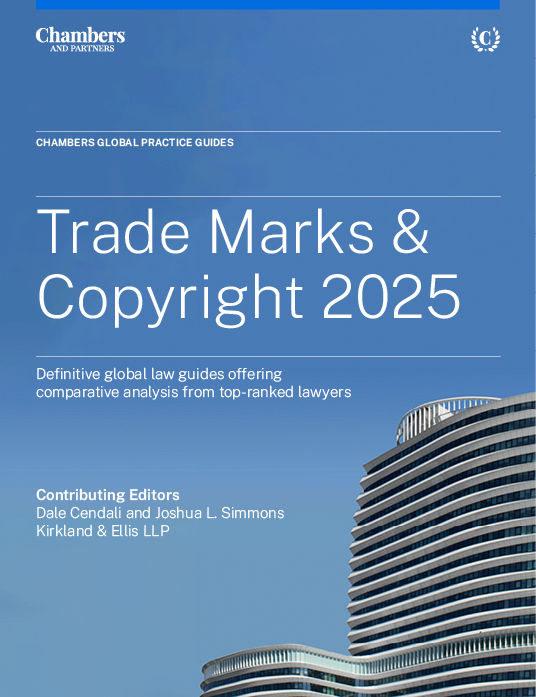
Trade Marks & Copyright 2025
The Trade Marks and Copyright 2025 guide features over 30 jurisdictions. The guide provides the latest legal information on domestic law and international conventions/treaties as they apply to trade marks and copyright; ownership, terms of protection and registration of rights; authorship, collective works and copyright management systems; opposition, revocation and cancellation procedures; assignment and licensing of rights; initiating a lawsuit; remedies; and appeals.
Last Updated: February 18, 2025
Compare law and practice by selecting locations and topic(s)
Select Locations

Select Topic(s)

Please select at least one location and one topic to use the compare functionality.
In the wake of the landmark US Supreme Court decisions Warhol v Goldsmith and Jack Daniels v VIP Products, both decided in 2023, 2024 provided courts and practitioners across the world with the opportunity to grapple with the practical applications of these decisions. In addition, 2024 brought its own landmark copyright and trade mark rulings in the EU, including decisions defining the parameters of the referential trade mark use exception and articulating the standard governing the scope of protection for works of applied art. Perhaps the most intriguing developments in copyright and trade mark law in 2024, however, came from the government reports, changes in law, clarifying judicial decisions, and revisions to practice standards dedicated to untangling the interaction between technological innovation and intellectual property, including the challenges and opportunities presented by generative AI and the metaverse.
Interaction Between Innovation and IP
Challenges and opportunities posed by generative AI
The continued development of generative AI, which uses machine learning to generate content, presents a number of challenges and opportunities for copyright and trade mark law. On 1 August 2024, the EU’s AI Act came into effect. Implementation of the regulations contained in the Act began in February 2025. In the absence of court decisions or statutes definitively ruling on the use of AI, other countries, like the US, are left to speculate about the effects of generative AI on derivative works and trade mark infringement. Still other countries, like Japan, have commissioned reports on the infringement risks and have drafted guidelines for the use of AI. While the practical effects of these statutes, writings, reports and guidelines are yet to be determined, it is worth taking a look at different approaches and concerns in the field of generative AI.
The EU
The EU AI Act took effect in August 2024, although the limitations and rules it contains did not begin to apply until 2025. The Act incorporates the exceptions and limitations on the use of copyrighted works for the purposes of text and data mining (TDM) first articulated in EU Directive 2019/790. This Directive provided a mandatory exception “to the exclusive right of reproduction and to the right to prevent extraction from a database” for universities, cultural heritage institutions, public-private partnerships with private sector research organisations, and other research organisations, when copyrighted works are used lawfully. Recital 105 of the EU AI Act allows copyright holders to “reserve their rights over their works or other subject matter to prevent text and data mining” where the TDM is not done as part of scientific research. If the copyright holder opts out “in an appropriate manner”, then researchers need to obtain permission to use the work for TDM. At this point, it is unclear what constitutes opting out “in an appropriate manner”, but organisations like Pictoright (Netherlands) and Sacem (France) have issued public statements that use of their members’ works for TDM purposes requires prior authorisation. The use of such statements is expected to increase as the provisions of the Act take effect.
In addition to implementing measures to avoid infringement, there are other considerations worth keeping in mind for AI developers, including:
- getting legal access to the copyrighted content used as training data;
- checking for the existence of opt-out statements;
- creating agreements with dataset owners and AI customers to divide liability for infringement; and
- limiting the use of training data content for other infringing purposes.
Japan
In Japan, as in much of the world, there have not been many laws or regulations passed or any judicial decisions regarding generative AI, although Japan did incorporate a TDM exception in Article 30(4) of its Copyright Law in 2018. As AI capabilities have increased, this exception has become increasingly relevant and Japan has responded by commissioning non-binding reports and guidelines addressing the challenges that generative AI presents for copyright law.
The first such report is the “Report on AI and Copyright Issues”, published on 15 March 2024 by the Legal System Subcommittee of the Cultural Council of Japan. It addresses three main topics: first, the risk of copyright infringement during the development of generative AI models; second, the risk of copyright infringement when using generative AI models; and third, the governing law that applies to copyright infringement regarding generative AI.
Infringement risk in development: While the Copyright Act of Japan does not have a generalised fair use defence, it does have the Non-Enjoyment Purpose Requirement, which allows for use of a copyrighted work in any way where the purpose is not for the user to enjoy the work. The use cannot, however, unreasonably prejudice the copyright holder’s interests. The test for whether a copyright holder’s interests are unreasonably prejudiced is whether the use conflicts with or hinders the market for the copyrighted work. The report addressed scenarios in which use of copyrighted works in the development of generative AI models hinders the market of the copyrighted work. The remedies for copyright infringement in the development of generative AI are injunctive relief and monetary damages.
Infringement risk in use: Evaluation for copyright infringement in Japan is the same for AI outputs as for traditional works – the infringing work must be similar to the copyrighted work and the infringing work must have relied on the copyrighted work. The report addresses two ways that an AI-generated work meets the reliance requirement and therefore infringes the copyrighted work – when the AI user recognises the copyrighted work, and when the AI user was unaware of the copyrighted work but the copyrighted work was included in the training data. On the other hand, if an AI user is not aware of the copyrighted work and the copyrighted work was not included in the training data, the reliance requirement is not likely to be met. When infringement occurs in the use of generative AI, the copyright holder could obtain injunctions against the user, the developer or the service provider.
Governing law:If the result of the copyright infringement occurs in Japan, then Japanese copyright law applies. Similarly, in claims for injunctive relief, Japanese law will apply to infringement occurring in Japan. In addition, Japanese law is more likely to apply when the server collecting the training data is located in Japan, when infringing AI outputs are generated by a program running on a server in Japan, and when a service provider publicly transmits infringing outputs created by generative AI to users in Japan.
In addition to the “Report on AI and Copyright Issues”, the Study Group on Intellectual Property Rights in the AI Era produced its interim report in May 2024. The interim report primarily considered risks of generative AI to intellectual property, and the protection of AI-based inventions. It concluded that, to fully address the risks regarding generative AI, the law needs to use a combination of the Intellectual Property Act, technology law and contract law.
Finally, the Japanese Ministry of Economy, Trade and Industry produced the AI guidelines for businesses, the “Guidelines for Utilization of Generative AI for Content Creation” and the “Checklist & Guidance on AI and Copyright”. These documents provide practical guidance for developers, providers and users working with AI. While these reports and guidelines are not legally binding, they provide valuable information to those working with AI in Japan.
The USA
There are several prominent cases involving AI that are working their way through the federal courts, most of which address the use of copyrighted works as inputs to train AI models. These cases include The New York Times Co v Microsoft Corp; Silverman v Open AI, Inc; and Kadrey v Meta Platforms. None of these cases have reached a verdict yet.
In this time of relative uncertainty in US intellectual property law, there are theoretical concerns about the outputs of generative AI, including the extent to which generative AI programs create unauthorised derivative works, infringing the copyrighted works used to train the AI model. The right to create derivative works belongs to the copyright holder. Yet when the output of a generative AI model reproduces or resembles elements of the copyrighted works used to train the model, one could argue that such output constitutes copyright infringement through the creation of an unauthorised derivative work. Such concerns have only been amplified since the Supreme Court’s 2023 decision in Warhol v Goldsmith, which sharpened the distinction between uses that are merely derivative and those that can be considered transformative, and therefore potentially non-infringing.
Digital evolution of trade mark law in Spain
In Spain, one key area of interest is the protection of trade marks in virtual environments. The development of NFTs, growth of online branding, and expansion of the metaverse have caused both Spain and the European Union to revise their trade mark practices.
The US “MetaBirkin” case, finding that NFTs of Hermès’ famous Birkin bag infringed Hermès’ trade mark, highlights the issue of how trade marks should be treated in the digital space. In anticipation of similar cases, the Spanish Patent and Trademark Office (SPTO) and the EU Intellectual Property Office (EUIPO) revised their guidelines, now requiring trade mark applications involving NFTs to detail the digital goods and services protected under the mark. The same is true for trade marks applying to virtual goods and services. To accommodate these new requirements, the Nice Classification system, the international classification for trade mark goods and services, has been revised to provide more detailed descriptions for NFTs and virtual goods and services.
In addition to preparing Spanish and EU trade mark applications for NFTs and virtual goods and services with the appropriate level of specificity, businesses offering both tangible and virtual goods and services are encouraged to make sure their existing trade marks adequately protect their virtual offerings. As trade marks are becoming increasingly important in the metaverse, there are also significant opportunities for infringing or counterfeit content. Spanish courts may be faced with disputes over digital uses of trade marks with increasing frequency moving forward.
Given the fast pace at which technological developments occur, practitioners working in Spain and the EU are encouraged to pay close attention to the legal changes in this space moving forward.


